Combat hinds
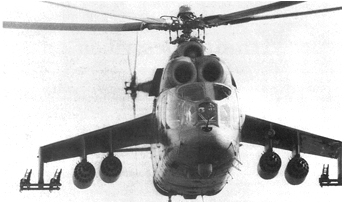
 The first combat and assault Mil' Mi-24 "Hind" helicopters (1) deployed outside the borders
of the USSR were observed for the first time at Stendal on September 26, 1973 together with a few Mi-8T "Hip-C."
This was the first operational version Mi-24A "Hind-A" assigned to the new 178.OBVP - Separate Combat Helicopter Regiment (2)
- likely created to implement the new helicopter in the GDR. More helicopters were also identified at Parchim, where the newly arrived
172.OBVP had settled down a few months earlier. The arrival of these first "Hind" announced the beginning of a considerable strengthening of the fire
power of the Group of Soviet Forces in Germany (GSFG). Intensive training began rapidly at the 178.OBVP from September on.
There was yet no Army Aviation Combat Training Course for the Mi-24 and the Mi-8 Combat Training Course was used for training.
The retractable landing gear was something really new for the helicopter pilots. They landed Mi-24s on their belly several times early during the establishment of the regiment.
An "observer" position was introduced within the tower to prevent such incidents. Using binoculars,
he visually monitored whether or not the gear were extended during flying activity when helicopters were landing.
In 1974, there were flights in two shifts during three to four flying days per week. Numerous missions were flown to the Retzow Air-to-Ground Bombing and Gunnery Range and to
the Letzlinger Heide training range. The pilots also practiced the simple overflight of the infantry since often during exercises the "non-battled tested"
youngsters fled in horror from the friendly roaring Mi-24s passing overhead at extremely low altitudes.
It was also necessary to master the 9M17M Falanga-M (AT-2 "Swatter") anti-tank missiles.
The Mi-24A could indeed carry four of those missiles that were mounted on launching rails attached
to the wingtip endplates. The front-seat operator guided them manually through orders given by a radio
link (a fairing under the nose protected the Raduga-F weapon system guidance antenna). He
used a tank sight for that purpose: the Falanga (Phalanx) had in fact originally been
developed to equip BDRM-1 and -2 light armored vehicles. This subsonic weapon (540 km/h) could
penetrate shielding up to 28 cm thick at distances ranging from 1000 to 4000 meters. However, the hit
probability with one missile on a target did not exceed 30%.
The first combat and assault Mil' Mi-24 "Hind" helicopters (1) deployed outside the borders
of the USSR were observed for the first time at Stendal on September 26, 1973 together with a few Mi-8T "Hip-C."
This was the first operational version Mi-24A "Hind-A" assigned to the new 178.OBVP - Separate Combat Helicopter Regiment (2)
- likely created to implement the new helicopter in the GDR. More helicopters were also identified at Parchim, where the newly arrived
172.OBVP had settled down a few months earlier. The arrival of these first "Hind" announced the beginning of a considerable strengthening of the fire
power of the Group of Soviet Forces in Germany (GSFG). Intensive training began rapidly at the 178.OBVP from September on.
There was yet no Army Aviation Combat Training Course for the Mi-24 and the Mi-8 Combat Training Course was used for training.
The retractable landing gear was something really new for the helicopter pilots. They landed Mi-24s on their belly several times early during the establishment of the regiment.
An "observer" position was introduced within the tower to prevent such incidents. Using binoculars,
he visually monitored whether or not the gear were extended during flying activity when helicopters were landing.
In 1974, there were flights in two shifts during three to four flying days per week. Numerous missions were flown to the Retzow Air-to-Ground Bombing and Gunnery Range and to
the Letzlinger Heide training range. The pilots also practiced the simple overflight of the infantry since often during exercises the "non-battled tested"
youngsters fled in horror from the friendly roaring Mi-24s passing overhead at extremely low altitudes.
It was also necessary to master the 9M17M Falanga-M (AT-2 "Swatter") anti-tank missiles.
The Mi-24A could indeed carry four of those missiles that were mounted on launching rails attached
to the wingtip endplates. The front-seat operator guided them manually through orders given by a radio
link (a fairing under the nose protected the Raduga-F weapon system guidance antenna). He
used a tank sight for that purpose: the Falanga (Phalanx) had in fact originally been
developed to equip BDRM-1 and -2 light armored vehicles. This subsonic weapon (540 km/h) could
penetrate shielding up to 28 cm thick at distances ranging from 1000 to 4000 meters. However, the hit
probability with one missile on a target did not exceed 30%.
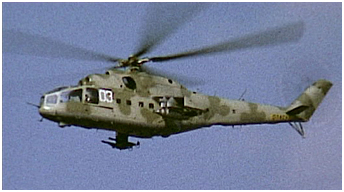
 The Mi-24 itself developed faster than the weapon system specifically intended for it. Consequently,
the 'A' version just used the same type of missiles than those previously used with the Mi-4AV
(3) as well as well as the K-4V weapon system of the latter.
This complex was also fitted to the Mi-8TV "Hip-E" (1974) that also carried four
Falanga ATGM. Thus, the GSFG had Mi-8 and Mi-24 with anti-tank capabilities on strength
for a few years and at the same time. A swiveling Afanas'yev A-12 machine gun, of a caliber of 12,7 mm
was mounted under the nose, while four wing pylons allowed the carriage of various weapons such as
four UB-32A rocket launchers that could fire 32 57 mm S-5 rockets each or four bombs weighing 50 to
250 kg. It was also possible to carry two 500 kg bombs or ZB-500 napalm canisters.
The Mi-24 itself developed faster than the weapon system specifically intended for it. Consequently,
the 'A' version just used the same type of missiles than those previously used with the Mi-4AV
(3) as well as well as the K-4V weapon system of the latter.
This complex was also fitted to the Mi-8TV "Hip-E" (1974) that also carried four
Falanga ATGM. Thus, the GSFG had Mi-8 and Mi-24 with anti-tank capabilities on strength
for a few years and at the same time. A swiveling Afanas'yev A-12 machine gun, of a caliber of 12,7 mm
was mounted under the nose, while four wing pylons allowed the carriage of various weapons such as
four UB-32A rocket launchers that could fire 32 57 mm S-5 rockets each or four bombs weighing 50 to
250 kg. It was also possible to carry two 500 kg bombs or ZB-500 napalm canisters.
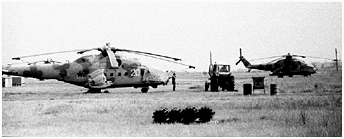 More than 240 Mi-24A were produced by Arsen'yev Factory n°116 between 1970 (entry into service
with the VVS in 1972) and early 1975.
Whereas "Hind" pilots generally were pleased with the agility of such a big and heavy helicopter, the tail rotor located
on the right side of the tail fin was insufficient. Its subsequent displacement to the left side solved the problem (the tail rotor switched from
a "pusher" to a "tractor" configuration). Also, the service life of the Izotov TV3-117 turbines was initialy limited to 50 hours. The engine potential
before overhaul was increased to 300 hours
with the Series 2 turbines in 1973 and 500 hours in 1975. By 1977, the Series 3 engines had reached a potential of 750 hours.
A few examples of the Mi-24U "Hind-C" trainer version were
also built. The latter was unarmed: it had no gun and no Raduga-F (some helicopters however kept that weapon system and were consequently able to fire ATGM).
The instructor was seating in the front seat where all the instrumentation and flight controls were available. At least one Mi-24U was based at Parchim.
However, we ignore if the Mi-24DU "Hind-D" that was the training version of the
next operational version, the Mi-24D, was deployed in the GDR.
More than 240 Mi-24A were produced by Arsen'yev Factory n°116 between 1970 (entry into service
with the VVS in 1972) and early 1975.
Whereas "Hind" pilots generally were pleased with the agility of such a big and heavy helicopter, the tail rotor located
on the right side of the tail fin was insufficient. Its subsequent displacement to the left side solved the problem (the tail rotor switched from
a "pusher" to a "tractor" configuration). Also, the service life of the Izotov TV3-117 turbines was initialy limited to 50 hours. The engine potential
before overhaul was increased to 300 hours
with the Series 2 turbines in 1973 and 500 hours in 1975. By 1977, the Series 3 engines had reached a potential of 750 hours.
A few examples of the Mi-24U "Hind-C" trainer version were
also built. The latter was unarmed: it had no gun and no Raduga-F (some helicopters however kept that weapon system and were consequently able to fire ATGM).
The instructor was seating in the front seat where all the instrumentation and flight controls were available. At least one Mi-24U was based at Parchim.
However, we ignore if the Mi-24DU "Hind-D" that was the training version of the
next operational version, the Mi-24D, was deployed in the GDR.
| Hind at Retzow |
Crocodiles (Nickname of the Mi-24)
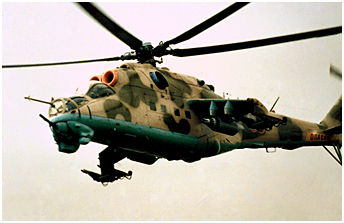
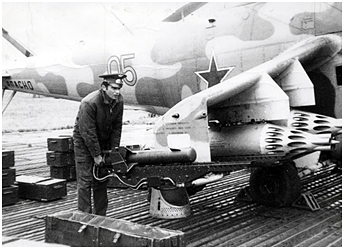 Production of the Mi-24D "Hind-D" was launched in 1973 at Rostov Factory n°168. Some 625 Mi-24D/DU had been built when
their production ceased in late 1983. Since the Shturm missiles that should have armed the Mi-24A still were not available, the
Mi-24D was an interim model that compensated for the deficiencies of the "Hind-A." The "veranda" - as
the Soviets called it - of the cockpit did not offer an ideal field of vision, far from it. During night sorties
near the ground, lights on the ground were reflected in the flat canopy glass, which sometimes caused the
pilot to lose spatial orientation. Moreover, the common cockpit decreased the chances of surviving a
direct hit to that area, the pilot and the weapons system operator being at risk of being injured or killed at
the same time. It was replaced by the double tandem cockpit equipped with bulletproof glass in front, so
characteristic of the Mi-24.
This version also benefited from various improvements previously tested on the Mi-24B, which did
not become operational. The nose machine-gun was replaced by a USPU-24 nose turret with a Gatling-type 12,7 mm machine-gun,
the Yakushev/Borzov YakB-12,7 (also designated 9-A-624
(4)) with a rate-of-fire of 4000-5000
rounds per minute and a combat load of 1470 shells. It was associated with the KPS-53AV stabilized gun
sight system. The latter included a VSB-24 ballistic calculator linked to sensors recording flight parameters,
enabling automatic aiming correction (5). That complex included the KS-53 gun sight with which the
weapons system operator (WSO) could fire the machine-gun and also drop bombs (the pilot could only drop them in emergency).
The pilot had a PKV collimator that he used to fire the unguided rockets.
Production of the Mi-24D "Hind-D" was launched in 1973 at Rostov Factory n°168. Some 625 Mi-24D/DU had been built when
their production ceased in late 1983. Since the Shturm missiles that should have armed the Mi-24A still were not available, the
Mi-24D was an interim model that compensated for the deficiencies of the "Hind-A." The "veranda" - as
the Soviets called it - of the cockpit did not offer an ideal field of vision, far from it. During night sorties
near the ground, lights on the ground were reflected in the flat canopy glass, which sometimes caused the
pilot to lose spatial orientation. Moreover, the common cockpit decreased the chances of surviving a
direct hit to that area, the pilot and the weapons system operator being at risk of being injured or killed at
the same time. It was replaced by the double tandem cockpit equipped with bulletproof glass in front, so
characteristic of the Mi-24.
This version also benefited from various improvements previously tested on the Mi-24B, which did
not become operational. The nose machine-gun was replaced by a USPU-24 nose turret with a Gatling-type 12,7 mm machine-gun,
the Yakushev/Borzov YakB-12,7 (also designated 9-A-624
(4)) with a rate-of-fire of 4000-5000
rounds per minute and a combat load of 1470 shells. It was associated with the KPS-53AV stabilized gun
sight system. The latter included a VSB-24 ballistic calculator linked to sensors recording flight parameters,
enabling automatic aiming correction (5). That complex included the KS-53 gun sight with which the
weapons system operator (WSO) could fire the machine-gun and also drop bombs (the pilot could only drop them in emergency).
The pilot had a PKV collimator that he used to fire the unguided rockets.
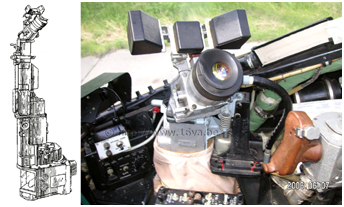
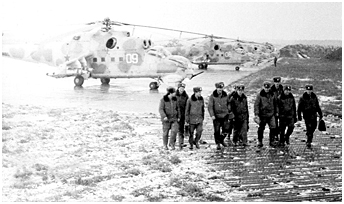 The 9M17M missile was replaced by the 9M17P Falanga-PV, associated with
Raduga-PF. The probability of a direct hit on the target was improved to 80% with this
improved version of the ATGM. The Raduga complex included a new target aiming and
acquisition system. It was originally a submarine periscope dating back to the 1930s mounted upside down!
The top side of the latter was in the right front corner of the WSO cockpit, while the other end of the
periscope was located inside a new fairing below the right side of the nose.
But, of course, this piece of equipment that was obviously satisfactory had to be adapted to its new
task. Thus, the mirror was gyro-stabilized.
Also, it was possible to choose between a narrow or wide field of view. An integrated thermal seeker
allowed automatic tracking of the position of the missile, the latter being equipped with two tracers at the
rear. The trajectory of the missile was then corrected by radio-link, while the WSO continually kept the
sight crosshairs on the target until impact. Two small metal doors protected the windows of the optics when not in use.
The 9M17M missile was replaced by the 9M17P Falanga-PV, associated with
Raduga-PF. The probability of a direct hit on the target was improved to 80% with this
improved version of the ATGM. The Raduga complex included a new target aiming and
acquisition system. It was originally a submarine periscope dating back to the 1930s mounted upside down!
The top side of the latter was in the right front corner of the WSO cockpit, while the other end of the
periscope was located inside a new fairing below the right side of the nose.
But, of course, this piece of equipment that was obviously satisfactory had to be adapted to its new
task. Thus, the mirror was gyro-stabilized.
Also, it was possible to choose between a narrow or wide field of view. An integrated thermal seeker
allowed automatic tracking of the position of the missile, the latter being equipped with two tracers at the
rear. The trajectory of the missile was then corrected by radio-link, while the WSO continually kept the
sight crosshairs on the target until impact. Two small metal doors protected the windows of the optics when not in use.
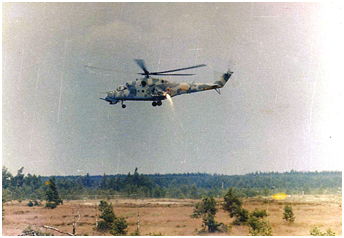
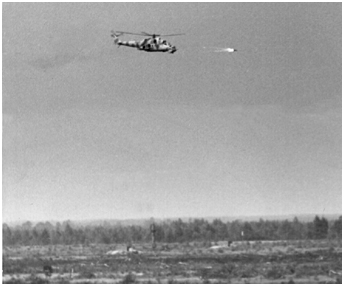 The missile's guidance antenna was now housed in a small swiveling fairing attached under the left side of the nose.
Unlike its predecessor, the Mi-24D could carry PTB-450 external fuel tanks under-wing. Four ASO-2V-02 removable infrared
decoy launchers containing 32 flares each could be attached under the rear
portion of the tail boom. A SPO-10 Sirena-3M radar homing and warning receiver (RHWR)
also protected the helicopter.
The missile's guidance antenna was now housed in a small swiveling fairing attached under the left side of the nose.
Unlike its predecessor, the Mi-24D could carry PTB-450 external fuel tanks under-wing. Four ASO-2V-02 removable infrared
decoy launchers containing 32 flares each could be attached under the rear
portion of the tail boom. A SPO-10 Sirena-3M radar homing and warning receiver (RHWR)
also protected the helicopter.
The introduction of the Mi-24D would gradually further increase the fire power of the GSFG.
In addition to the replacement of the Mi-24A in the 172.OBVP in 1976 and in the 178.OBVP
probably during the same time frame, two new "Hind-D" regiments arrived, one at Brandis in 1977
(225.OBVP) and the other at Nohra in 1979 (336.OBVP). The 440.OVP BU established at Stendal much
later in 1987 was still equipped (in totality or partially?) with Mi-24D. When it left Germany in 1992, that
unit was still flying something like two dozen 'D' models alongside one dozen 'V' models.
Similarly, the 225.OBVP that joined Allstedt in 1985 was still flying some Mi-24D in 1991 (the unit
was equipped with approximately 20 'D' and 20 'V' models).
| Blocking at Nohra |
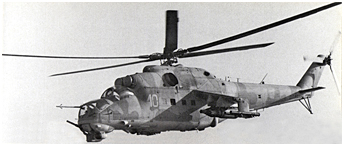 Production of the Mi-24V "Hind-E" began in 1976 and, ten years later, around 1500 machines had
been built in Arsen'yev and Rostov. The letter 'V' in the designation meant Vysotnyy or
"high-altitude" in English. This version was indeed powered by more-powerful Izotov TV3-117V
turbines that could deliver up to 2225 hp - hence its ability to operate more easily at a higher altitude
- while the Mi-24A and 'D' used TV3-117 turbines rated at 2200 hp.
In addition, the TV3-117V could still provide 1700 hp at 1000 meters and 40°C, while the TV3-117
could only provide 1420 hp under the same conditions.
The Mi-24V was finally armed with 9M114 Shturm-V (AT-6 "Spiral") ATGM.
The new supersonic missile flying at 1260-1440 km/h could pierce shielding 56 cm thick at a distance
ranging from 800 to 5000 meters. The hit probability on a target now exceeded 92%. Thanks to its more
compact shape and its folding stabilizers, it could be stored inside a cylindrical container.
Production of the Mi-24V "Hind-E" began in 1976 and, ten years later, around 1500 machines had
been built in Arsen'yev and Rostov. The letter 'V' in the designation meant Vysotnyy or
"high-altitude" in English. This version was indeed powered by more-powerful Izotov TV3-117V
turbines that could deliver up to 2225 hp - hence its ability to operate more easily at a higher altitude
- while the Mi-24A and 'D' used TV3-117 turbines rated at 2200 hp.
In addition, the TV3-117V could still provide 1700 hp at 1000 meters and 40°C, while the TV3-117
could only provide 1420 hp under the same conditions.
The Mi-24V was finally armed with 9M114 Shturm-V (AT-6 "Spiral") ATGM.
The new supersonic missile flying at 1260-1440 km/h could pierce shielding 56 cm thick at a distance
ranging from 800 to 5000 meters. The hit probability on a target now exceeded 92%. Thanks to its more
compact shape and its folding stabilizers, it could be stored inside a cylindrical container.
 Ce Mi-24V photographié à Parchim le 3 février 1984 emportait sous les pylones externes des adaptateurs permettant d'y fixer quatre missiles antichars. Un "Hind-E" équipé
de la sorte pouvait par conséquent emporter jusqu'à 16 missiles si deux adaptateurs doubles étaient montés en bout de plans. Celui-ci ne transportait que deux Chtourm
et deux conteneurs UB-32A. © USMLM.
Ce Mi-24V photographié à Parchim le 3 février 1984 emportait sous les pylones externes des adaptateurs permettant d'y fixer quatre missiles antichars. Un "Hind-E" équipé
de la sorte pouvait par conséquent emporter jusqu'à 16 missiles si deux adaptateurs doubles étaient montés en bout de plans. Celui-ci ne transportait que deux Chtourm
et deux conteneurs UB-32A. © USMLM.
This Mi-24V was photographed at Parchim on February 3, 1984. It was carrying stacked Shturm ATGM mounts (4 missiles) on its outer universal wing
pylons. An helicopter equipped like this one could carry up to 16 missiles when two twin adapters were mounted at the wing endplates. This "Hind" had only two missiles and two UB-32A
rocket pods under its wings. © USMLM.
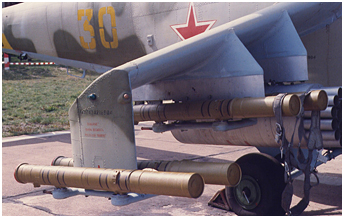 The "Hind-E" carried two hard points for these missiles at the wing endplates. Experiments were
conducted around 1986 to increase the firepower of the Mi-24V by doubling the number of missiles
attached to the wing tips and also by hanging under the outboard wing pylons double racks that could
carry four additional missiles each (they were probably the same type of rack as that fitted to the Ka-29).
Therefore, a Mi-24V in that configuration could carry up to 16 anti-tank missiles!
We hardly dare to imagine the devastation that a single squadron equipped like that could, at least
theoretically, have inflicted on the armored forces of NATO... However, we do not know to what extent
that weapon configuration had been implemented at the unit level. The fact is that such a configuration
was observed at least partially in the GDR, as shown in the photo above left. The usual configuration,
however, was limited to two missiles attached to the wing tips (four missiles in total), sometimes
augmented by two additional missiles attached to double racks under each outer wing pylon (eight
missiles in total).
The "Hind-E" carried two hard points for these missiles at the wing endplates. Experiments were
conducted around 1986 to increase the firepower of the Mi-24V by doubling the number of missiles
attached to the wing tips and also by hanging under the outboard wing pylons double racks that could
carry four additional missiles each (they were probably the same type of rack as that fitted to the Ka-29).
Therefore, a Mi-24V in that configuration could carry up to 16 anti-tank missiles!
We hardly dare to imagine the devastation that a single squadron equipped like that could, at least
theoretically, have inflicted on the armored forces of NATO... However, we do not know to what extent
that weapon configuration had been implemented at the unit level. The fact is that such a configuration
was observed at least partially in the GDR, as shown in the photo above left. The usual configuration,
however, was limited to two missiles attached to the wing tips (four missiles in total), sometimes
augmented by two additional missiles attached to double racks under each outer wing pylon (eight
missiles in total).
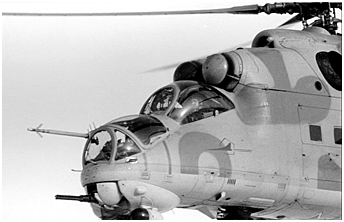
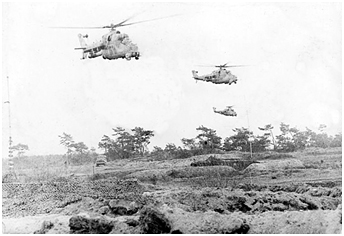 The missile guidance antenna of the Raduga-Sh (Sh for 'Shturm') was a little more bulky.
This moving antenna was housed inside a fixed teardrop fairing with a black dielectric panel in front,
attached to the left side of the nose turret. This fairing made it possible to distinguish definitively
a Mi-24V from a Mi-24D.
The pilot was employing a new ASP-17V automatic sight that could be used for firing the nose
machine-gun in a fixed (zero) position, to drop bombs and fire unguided rockets (6).
The first "Hind-E" models had no PZU air intake filters in front of the turbines. These filters were
fitted out on the later Mi-24V series and they were often retrofitted on the early series machines, as well
as on the Mi-24D.
The Mi-24V of the GSFG were not equipped with the SPO-15 Bereza RHAWR that
could be recognized by its prominent fairings positioned behind the cockpit and on the tail boom. They
retained instead the older SPO-10 system.
The missile guidance antenna of the Raduga-Sh (Sh for 'Shturm') was a little more bulky.
This moving antenna was housed inside a fixed teardrop fairing with a black dielectric panel in front,
attached to the left side of the nose turret. This fairing made it possible to distinguish definitively
a Mi-24V from a Mi-24D.
The pilot was employing a new ASP-17V automatic sight that could be used for firing the nose
machine-gun in a fixed (zero) position, to drop bombs and fire unguided rockets (6).
The first "Hind-E" models had no PZU air intake filters in front of the turbines. These filters were
fitted out on the later Mi-24V series and they were often retrofitted on the early series machines, as well
as on the Mi-24D.
The Mi-24V of the GSFG were not equipped with the SPO-15 Bereza RHAWR that
could be recognized by its prominent fairings positioned behind the cockpit and on the tail boom. They
retained instead the older SPO-10 system.
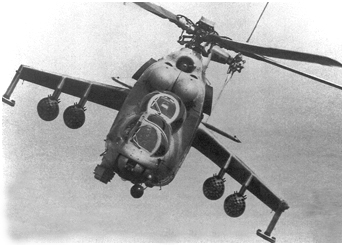
 Like the Mi-24D, the Mi-24V could carry four ASO-2V-02 IR flare launchers, each containing 32
flares, under the tail boom. These later were replaced by six identical dispensers mounted on the rear of
the fuselage sides (three on each side). They were fixed at an angle of about 15° forward and were
sometimes shrouded with an aerodynamic fairing. The flares were launched automatically at a rate of
between four to sixteen at one time at two- to six-second intervals.
A support for an SOEP-V1A IR jammer Lampa infrakrasnykh pomekh (infrared
jamming lamp) generally designated Lipa - "Hot Brick" for NATO (7)
- was located behind the
main rotor, at the root of the tail boom. The Lipa was composed of a xenon lamp and a rotating deflector accommodated in a
thimble-shaped housing.
This system produced erratic infrared signals that disrupted an IR missile guidance system. The first
Mi-24V series did not have that equipment, while some late-series Mi-24D were equipped with it. This
type of material, however, was retrofitted on many older "Hind-D" and "-E" models.
It was possible to adapt EVU gas diluters on the engine exhausts to reduce the IR signature of the
helicopter. However, that was possible only on those machines produced after 1984 that were equipped
with exhaust nozzles cut vertically (rather than beveled) and, until proven otherwise, the only helicopters of the GSFG that could have received that
equipment were the Mi-24K and R models (8).
Like the Mi-24D, the Mi-24V could carry four ASO-2V-02 IR flare launchers, each containing 32
flares, under the tail boom. These later were replaced by six identical dispensers mounted on the rear of
the fuselage sides (three on each side). They were fixed at an angle of about 15° forward and were
sometimes shrouded with an aerodynamic fairing. The flares were launched automatically at a rate of
between four to sixteen at one time at two- to six-second intervals.
A support for an SOEP-V1A IR jammer Lampa infrakrasnykh pomekh (infrared
jamming lamp) generally designated Lipa - "Hot Brick" for NATO (7)
- was located behind the
main rotor, at the root of the tail boom. The Lipa was composed of a xenon lamp and a rotating deflector accommodated in a
thimble-shaped housing.
This system produced erratic infrared signals that disrupted an IR missile guidance system. The first
Mi-24V series did not have that equipment, while some late-series Mi-24D were equipped with it. This
type of material, however, was retrofitted on many older "Hind-D" and "-E" models.
It was possible to adapt EVU gas diluters on the engine exhausts to reduce the IR signature of the
helicopter. However, that was possible only on those machines produced after 1984 that were equipped
with exhaust nozzles cut vertically (rather than beveled) and, until proven otherwise, the only helicopters of the GSFG that could have received that
equipment were the Mi-24K and R models (8).
 Un escadron du 487.OVP BU sur le départ à Werneuchen le 9 août 1993. © H.Mambour.
Un escadron du 487.OVP BU sur le départ à Werneuchen le 9 août 1993. © H.Mambour.A squadron of the 487.OVP BU ready to leave Werneuchen on 9 August 1993. © H.Mambour. |
notes
(1)
The Mi-24 was not solely a combat helicopter: it could carry up to eight armed infantrymen in the rear compartment. The windows of that
compartment could be opened and a machine gun support was placed at their base. However, missions with infantryman aboard were
not the
more common.
The cockpit and rear compartment were pressurized for protection against NBC fallout.
It was possible to carry two stretchers and medical equipment in a medevac configuration.
The crew consisted of a pilot, an operator of the weapon system (WSO) with basic flight controls at
his disposition and a flight engineer seated on
a folding chair just behind the pilot, in the passage leading
to the rear compartment. Each crew member had a parachute.
(2) For further explanation of the organization and designation of the units, read the introductory
chapter 4.1
(3)
The Mi-4AV "Hound-C" entered service in 1968. Nearly 185 Mi-4A were converted according to
the standards of this combat variant, which was
equipped with two triple racks for six UB-16-57 rocket
launchers, or a maximum one ton of bombs.
In addition, four rails were fixed above the
racks to carry four 9M17M Falanga ATGM.
Finally, a 12,7 mm machine gun was housed in a ventral gondola. This was a lot for a machine that
had not been designed for this purpose: the power-to-weight ratio was low and neither the crew nor vital
helicopter systems had protection.
(4) Designation of the Chief Rocket and Artillery Directorate (GRAU).
(5) The VSB-24 computer used probes located on the nose boom (DUAS-V, Datchik Ugla Ataki i Skol'zheniya-Vertoletnyy
- helicopter angle of
attack and side-slip sensor) to calculate a firing solution. Very surprisingly, some GSFG Mi-24D flew without this boom as evidenced by NVA
Information Bulletin 12/1979 > Link. Beginning at 2'42",
we can see several Mi-24D without a nose boom. At 4'31", we can see that the base to
mount one was present and neatly faired over. One could speculate for a long time as to the possible reasons for the temporary absence of this
boom. The KPS-53AV could work without the VSB-24 computer, but the latter reduced the crew workload by making automatic corrections.
Let us take this opportunity to point out another interesting observation: at 2'35", we can see an Mi-8T without an OPB-1R bombsight aperture
under the nose (see > The Mi-8, part 1).
(6)
Mi-24V or P were equipped with a laser range finder in Afghanistan. The device was located in lieu of the fourth cabin window on the right side.
That discreet small box was covered with the international symbol indicating radioactivity. Helicopters equipped with such devices were based in
USSR during the late nineties.
(7)
Incidently, "Hot brick" was rather appropriate as one Mi-24 crew member remembers:
"Those practical helicopter drivers also found a domestic
use for this truly universal system, having modified it into a powerful "oven" to cook potatoes
and heat water for the teapot."
(8)
The twelve Mi-24P of the NVA delivered in 1989 had that equipment although it was only tested on the ground.
 |
The Mi-24 > Part 2 | > Part 3 |
 |
Plan du site - Sitemap |  |
